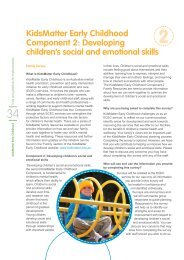KidsMatter Early Childhood Connecting with the Early Childhood ...
KidsMatter Early Childhood Connecting with the Early Childhood ...
KidsMatter Early Childhood Connecting with the Early Childhood ...
- No tags were found...
Create successful ePaper yourself
Turn your PDF publications into a flip-book with our unique Google optimized e-Paper software.
ContentsContext 2Supporting <strong>the</strong> National Quality Framework 4Case study 5<strong>KidsMatter</strong> <strong>Early</strong> <strong>Childhood</strong> Component 1 6Creating a sense of community<strong>KidsMatter</strong> <strong>Early</strong> <strong>Childhood</strong> Component 2 8Developing children’s social and emotional skills<strong>KidsMatter</strong> <strong>Early</strong> <strong>Childhood</strong> Component 3 10Working <strong>with</strong> parents and carers<strong>KidsMatter</strong> <strong>Early</strong> <strong>Childhood</strong> Component 4 12Helping children who are experiencing mental health difficultiesConclusion 14References 15Contact details 16
ContextThere is concerted agreement that <strong>the</strong> early yearsof a child’s life represent a vital period of growth,development and learning and that <strong>the</strong> qualityof experiences in <strong>the</strong>se years has a powerfulimpact—positively or negatively—on <strong>the</strong> individual’slong-term wellbeing and success (McCain & Mustard,1999). Governments around <strong>the</strong> world have beenconvinced that investing in support for <strong>the</strong> familiesof young children and in high-quality education andcare, brings substantial benefits for <strong>the</strong> individualand for society (Gallinsky, 2006).A number of initiatives currently underway inAustralia focus on improving early childhoodeducation and care <strong>with</strong> <strong>the</strong>se benefits in mind.In July 2009, <strong>the</strong> Council of Australian Governments(COAG) endorsed ‘Australia’s first ever overarchingnational strategy for early childhood development.Investing in <strong>the</strong> <strong>Early</strong> Years: A National <strong>Early</strong><strong>Childhood</strong> Development Strategy…outlines a sharedvision…that by 2020…all children have <strong>the</strong> best startin life to create a better future for <strong>the</strong>mselves andfor <strong>the</strong> nation’ (COAG <strong>Early</strong> <strong>Childhood</strong> DevelopmentSteering Committee, 2009, p. 2).A National Quality Framework for early childhoodeducation and care was endorsed by COAG inDecember 2009 as a key mechanism for achieving<strong>the</strong> Strategy’s vision for young children in Australia.The National Quality Framework includes a NationalQuality Standard (NQS) and an <strong>Early</strong> Years LearningFramework (EYLF) designed to raise quality insettings catering for young children.<strong>KidsMatter</strong> <strong>Early</strong> <strong>Childhood</strong> has a potentiallysignificant part to play in <strong>the</strong> national missionto enhance early childhood provision.Nationally, we have a golden opportunityto streng<strong>the</strong>n connections between <strong>the</strong>seinitiatives for strategic efficiency and improvedoutcomes for children and families.PurposeThis document aims to make explicit <strong>the</strong>connections between <strong>the</strong> <strong>KidsMatter</strong> <strong>Early</strong> <strong>Childhood</strong>Initiative and <strong>the</strong> National Quality Standard (NQS),which has <strong>the</strong> <strong>Early</strong> Years Learning Framework (EYLF)embedded <strong>with</strong>in it.Both <strong>the</strong> NQS and <strong>KidsMatter</strong> <strong>Early</strong> <strong>Childhood</strong> areunderwritten by COAG agreements—<strong>the</strong> COAGNational Quality Framework for <strong>Early</strong> Educationand Care and <strong>the</strong> COAG National Action Plan onMental Health.Both of <strong>the</strong>se agreements are based on researchwhich affirms that children’s early social andemotional wellbeing underpins learning andlife outcomes:What, how and how much (children) learn at schoolwill depend in large part on <strong>the</strong> social and emotionalcompetence <strong>the</strong>y have developed as preschoolers(The Child Mental Health Foundations and AgenciesNetwork, 1999, Preface v).The single best predictor of adult adaptation isnot school grades, and not classroom behaviour,but ra<strong>the</strong>r <strong>the</strong> adequacy <strong>with</strong> which <strong>the</strong> child getsalong <strong>with</strong> o<strong>the</strong>r children. Children…who cannotestablish a place for <strong>the</strong>mselves in <strong>the</strong> peer cultureare seriously at risk (Hartup, 1992, p. 1, cited inLinke, 2011, p. 14).<strong>KidsMatter</strong> <strong>Early</strong> <strong>Childhood</strong> provides a continuousimprovement framework to enable early childhoodservices to plan and implement evidence-basedmental health promotion, prevention and earlyintervention strategies. The framework is basedon a positive psychology philosophy and uses arisk and protective factor model to focus on areaswhere early childhood services can streng<strong>the</strong>nprotective factors for improving children’s mentalhealth and minimise <strong>the</strong> effects of any risk factors.2<strong>KidsMatter</strong> <strong>Early</strong> <strong>Childhood</strong> <strong>Connecting</strong> <strong>with</strong> <strong>the</strong> <strong>Early</strong> <strong>Childhood</strong> Education and Care National Quality Framework
• <strong>KidsMatter</strong> specifically aims to developchildren’s social and emotional skills; <strong>the</strong>EYLF acknowledges that social and emotionalhealth and cognitive growth go hand in hand;and <strong>the</strong> emphasis in <strong>the</strong> NQS on relationships<strong>with</strong> children takes up <strong>the</strong> issues of social andemotional health strongly.<strong>KidsMatter</strong> <strong>Early</strong> <strong>Childhood</strong> adds substantial value to<strong>the</strong> o<strong>the</strong>r initiatives because it provides a frameworkfor explicitly teaching social and emotional skills and<strong>the</strong> knowledge, training and support that earlychildhood educators and families require so that<strong>the</strong>y can intervene in a timely and appropriateway to enhance children’s mental health andsocial adjustment.Data shows that children who are systematicallytaught social and emotional skills…have fewerproblems such as substance abuse and violence,like school more and pay more attention in class—and score significantly better (11% on average)on academic achievement test scores (Goleman,2008, p. 1).Kidsmatter <strong>Early</strong> <strong>Childhood</strong> has four componentsunder which early childhood education andcare services receive professional learning andresources which guide <strong>the</strong>ir planning for children’smental health:• Creating a sense of community• Developing social and emotional skills• Working <strong>with</strong> parents and carers• Helping children who are experiencing mentalhealth difficulties.<strong>KidsMatter</strong> <strong>Early</strong> <strong>Childhood</strong> and <strong>the</strong> NQS, including<strong>the</strong> EYLF, have much in common. They bothhave ‘relationships’ at <strong>the</strong>ir core and aim todevelop children’s social and emotional wellbeingand competence:This document maps <strong>the</strong> elements of <strong>the</strong> <strong>KidsMatter</strong>initiative onto <strong>the</strong> NQS, including <strong>the</strong> EYLF.It demonstrates that <strong>the</strong> <strong>KidsMatter</strong> initiative hasconsiderable potential to enable early childhoodservices to implement key elements of <strong>the</strong> NQSand to achieve National Quality Standard level.The analysis of connections between <strong>the</strong> initiativesincludes aspects of philosophical agreement andareas of direct congruence between goals andeducators’ actions.<strong>KidsMatter</strong> <strong>Early</strong> <strong>Childhood</strong>and <strong>the</strong> NQS, including <strong>the</strong>EYLF, have much in common.They both have ‘relationships’at <strong>the</strong>ir core and aim to developchildren’s social and emotionalwellbeing and competence.• <strong>KidsMatter</strong> Component 1 specifically addresses‘creating a sense of community’ and Component3 focuses on ‘working <strong>with</strong> parents and carers’;<strong>the</strong> EYLF sees a sense of ‘belonging’ as <strong>the</strong>foundation for children’s wellbeing and recognisesthat relationships are central to identity andengagement <strong>with</strong> learning; and <strong>the</strong> NQShighlights ‘relationships <strong>with</strong> children’ inQuality Area 5 and ‘collaborative partnerships<strong>with</strong> families’ in Quality Area 6.<strong>KidsMatter</strong> <strong>Early</strong> <strong>Childhood</strong> <strong>Connecting</strong> <strong>with</strong> <strong>the</strong> <strong>Early</strong> <strong>Childhood</strong> Education and Care National Quality Framework 3
Supporting <strong>the</strong> National Quality Framework<strong>KidsMatter</strong> <strong>Early</strong> <strong>Childhood</strong>Australian <strong>Early</strong> <strong>Childhood</strong> Mental Health InitiativeCreating a sense of communityDeveloping children’s social and emotional skillsWorking <strong>with</strong> parents and carersHelping children who are experiencing mental health difficulties<strong>Early</strong> Years Learning FrameworkBelonging, Being and BecomingLearning OutcomesChildren have a strong sense of identityChildren are connected <strong>with</strong> and contribute to <strong>the</strong>ir worldChildren have a strong sense of wellbeingChildren are confident and involved learnersChildren are effective communicatorsNational Quality StandardsEducational program and practiceChildren’s health and safetyPhysical environmentStaffing arrangementsRelationships <strong>with</strong> childrenCollaborative partnerships <strong>with</strong> families and communitiesLeadership and service management4<strong>KidsMatter</strong> <strong>Early</strong> <strong>Childhood</strong> <strong>Connecting</strong> <strong>with</strong> <strong>the</strong> <strong>Early</strong> <strong>Childhood</strong> Education and Care National Quality Framework
Case studyCreating a sense of community <strong>with</strong> KMECWhen an early childhood education and care service participates in <strong>KidsMatter</strong> <strong>Early</strong> <strong>Childhood</strong>(KMEC), <strong>the</strong>y review <strong>the</strong>ir practice and plan for <strong>the</strong> future under <strong>the</strong> four components that havebeen identified to benefit children’s mental health.In creating a sense of community under <strong>the</strong> KMEC framework, Smithdown Child Care Centrereviewed <strong>the</strong> four Target Areas of Belonging and connectedness, Positive relationships, Inclusionand Collaboration. The service staff identified what <strong>the</strong>y already did well under each Target Area,and areas where <strong>the</strong>y would like to do more.For example, Smithdown Child Care Centre already invited new families to visit <strong>the</strong> service andattend an interview before <strong>the</strong>y started, but during a planning session it was decided to try tobegin even earlier, before families placed <strong>the</strong>ir name on <strong>the</strong> waiting list. They began inviting familiesto visit <strong>with</strong> <strong>the</strong> child and talk about <strong>the</strong>ir needs and <strong>the</strong> needs of <strong>the</strong> child, before placing <strong>the</strong>irname on <strong>the</strong> waiting list. This gave <strong>the</strong> family <strong>the</strong> opportunity to view <strong>the</strong> environment, see o<strong>the</strong>rchildren ‘in action’ and ask questions. While on <strong>the</strong> waiting list, families would also be invited tocentre functions.Smithdown Child Care Centre was happy <strong>with</strong> its transition process. Once a family had a place, aninterview would occur. The child would also come along to give educators an opportunity to observe<strong>the</strong> child in <strong>the</strong> setting and decide how to best manage <strong>the</strong> transition. Where possible, this wouldoccur over several days so <strong>the</strong> family and child could become orientated <strong>with</strong>in <strong>the</strong> centre beforestarting. During <strong>the</strong> transition into <strong>the</strong> early childhood service, shorter days would be encouraged innegotiation <strong>with</strong> families and a special item from home welcomed, to assist <strong>the</strong> child in feeling safe.There are several copies of a centre book <strong>with</strong> photos that families can borrow to share toge<strong>the</strong>r.The Director of Smithdown Child Care Centre wanted to extend this even fur<strong>the</strong>r. An educatorwould be dedicated to each child and <strong>the</strong>y would take responsibility for communicating <strong>the</strong> child’sprogress to <strong>the</strong> family. Shifts would need to be changed to ensure <strong>the</strong> designated educator was<strong>the</strong>re to greet <strong>the</strong> new child and family at <strong>the</strong> start of <strong>the</strong>ir enrolment. This would also help tomaintain and build on <strong>the</strong>ir current practice, where information between families and educatorswas exchanged daily. Photos were taken and sent home to make connections.The new strategies were implemented<strong>with</strong> new families and reviewed to seehow effective <strong>the</strong>y were in terms of <strong>the</strong>impact <strong>the</strong>y had on <strong>the</strong> service’s senseof community.In reflecting on <strong>the</strong>ir practice in <strong>the</strong>seareas, <strong>the</strong> educators identified that <strong>the</strong>ywere also addressing many of <strong>the</strong> elementsof <strong>the</strong> EYLF and National Quality Standard,particularly those related to children’sfeelings of belonging and relationships<strong>with</strong> families.<strong>KidsMatter</strong> <strong>Early</strong> <strong>Childhood</strong> <strong>Connecting</strong> <strong>with</strong> <strong>the</strong> <strong>Early</strong> <strong>Childhood</strong> Education and Care National Quality Framework 5
<strong>KidsMatter</strong> <strong>Early</strong> <strong>Childhood</strong> Component 1Creating a sense of communityComponent 1 focuses on‘creating a sense of community’.The Target Areas of Component 1 connect <strong>with</strong> <strong>the</strong>overarching concepts of <strong>the</strong> EYLF—belonging, beingand becoming—and <strong>with</strong> three of <strong>the</strong> key Principleswhich underpin effective pedagogy and practice inearly childhood education and care—relationships,respect for diversity and partnerships.Implementing <strong>KidsMatter</strong> supports children’s learningand development across all five EYLF LearningOutcomes and Component 1 links most strongly<strong>with</strong> EYLF Outcome 1: Children have a strong senseof identity.The <strong>KidsMatter</strong> approach overall and especiallyComponent 1 are philosophically consistent <strong>with</strong><strong>the</strong> six guiding principles that apply to all sevenareas of <strong>the</strong> National Quality Standard.Component 1 contributes particularly to <strong>the</strong> NQSQuality Area 1: Educational program and practice.It is also very relevant to NQS Quality Area 5:Relationships <strong>with</strong> children.<strong>KidsMatter</strong> <strong>Early</strong> <strong>Childhood</strong>Component 1: Creatinga sense of communityKey Target Areas:Belonging andconnectedness:The early childhood serviceis welcoming, friendly andsupportive of children,families and staff.Inclusion:The early childhood serviceaddresses inclusion at a servicelevel to help children, familiesand staff to feel valued acrossall areas of diversity.Positive relationships:Secure, responsive andrespectful relationships areencouraged between staffand children; staff and families;staff; and staff and o<strong>the</strong>rprofessionals.Collaboration:Children, parents and carers andstaff work toge<strong>the</strong>r and haveopportunities to be involvedin planning, decision makingand contributing to a rangeof experiences in <strong>the</strong> service.<strong>Early</strong> Years LearningFrameworkEYLF overarching concepts:Belonging—to family, cultureand community is central toa strong sense of identity.Identity is built on relationshipsand shapes what childrencan become.Being—is about childrenenjoying <strong>the</strong> present,knowing <strong>the</strong>mselves andmeeting challenges.Becoming—is about howchildren’s identities, knowledge,capacities and skills changerapidly and significantly in<strong>the</strong> early years.EYLF Principles:Secure, respectful andreciprocal relationships:‘Educators who are attuned tochildren’s thoughts and feelings,support <strong>the</strong> development ofa strong sense of wellbeing’(p. 12).National QualityStandard ElementsNQS guiding principles:• The rights of <strong>the</strong> childare paramount• Children are successful,competent and capablelearners• Equity, inclusion anddiversity• Valuing Australia’sAboriginal and Torres StraitIslander cultures• The role of parents andfamilies is respected andsupported.Quality Area 1: Educationalprogram and practice‘The educational program andpractice is stimulating, engagingand enhances children’s learningand development’ (NQS Draft,December 2009 p.12).6<strong>KidsMatter</strong> <strong>Early</strong> <strong>Childhood</strong> <strong>Connecting</strong> <strong>with</strong> <strong>the</strong> <strong>Early</strong> <strong>Childhood</strong> Education and Care National Quality Framework
<strong>KidsMatter</strong> <strong>Early</strong> <strong>Childhood</strong><strong>Early</strong> Years LearningFrameworkRespect for diversity:‘Respecting diversity means<strong>with</strong>in <strong>the</strong> curriculum valuingand reflecting <strong>the</strong> practices,values and beliefs of families’(p. 13).Partnerships:Educators’ create a welcomingenvironment where all childrenand families are respectedand actively encouraged tocollaborate…about curriculumdecisions…Learning Outcome 1:Children have a strongsense of identity1.1 Children feel safe,secure and supported.1.2 Children develop <strong>the</strong>iremerging autonomy,interdependence,resilience and senseof agency.1.3 Children developknowledgeable andconfident self identities.1.4 Children learn to interactin relation to o<strong>the</strong>rs<strong>with</strong> care, empathyand respect.National QualityStandard ElementsStandards and elements:1.1 The <strong>Early</strong> Years LearningFramework (or o<strong>the</strong>rapproved learningframework) informs<strong>the</strong> development of aprogram for each childthat enhances <strong>the</strong>irlearning and development.1.1.2 Curriculum decisionmakingis informedby <strong>the</strong> context, settingand cultural diversityof <strong>the</strong> families and<strong>the</strong> community.1.2 The program foreach child takes intoaccount <strong>the</strong>ir strengths,capabilities, culture,interests and experiences.1.2.1 Each child’s currentknowledge, ideas,culture and interestsform <strong>the</strong> foundationfor <strong>the</strong> program.Quality Area 5: Relationships<strong>with</strong> children‘Relationships that areresponsive, respectful andpromote children’s senseof security and belongingfree <strong>the</strong>m to explore <strong>the</strong>environment and engagein learning’ (NQS Draft,December, 2009 p. 25).Standards and elements:5.1 Respectful andequitable relationshipsare developed andmaintained <strong>with</strong>each child.5.2 Each child is supportedto build and maintainsensitive and responsiverelationships <strong>with</strong> o<strong>the</strong>rchildren and adults.5.3 Each child’s behaviour,interactions andrelationships areguided effectively.<strong>KidsMatter</strong> <strong>Early</strong> <strong>Childhood</strong> <strong>Connecting</strong> <strong>with</strong> <strong>the</strong> <strong>Early</strong> <strong>Childhood</strong> Education and Care National Quality Framework 7
<strong>KidsMatter</strong> <strong>Early</strong> <strong>Childhood</strong> Component 2Developing children’s social and emotional skillsComponent 2 focuses on‘developing children’s socialand emotional skills’.The evidence for <strong>the</strong> importance of socialand emotional learning is overwhelming.Emotional skills are about learning to manage andexpress feelings appropriately. Social skills are aboutrelating to o<strong>the</strong>rs.Without social and emotional skills children cannotlearn as effectively and cannot make <strong>the</strong> most of<strong>the</strong>ir learning.[These skills]…need to be taught in a planned wayas well as through modelling and capitalising onteaching opportunities (Linke, 2011, p. 15).<strong>KidsMatter</strong> Component 2 complements two keyPrinciples of <strong>the</strong> EYLF—relationships and reflectivepractice—and two EYLF Practices—responsiveness tochildren and intentional teaching. Component 2 hasclear links <strong>with</strong> EYLF Learning Outcome 3: Childrenhave a strong sense of wellbeing; <strong>with</strong> LearningOutcome 2: Children are connected <strong>with</strong> andcontribute to <strong>the</strong>ir world; and <strong>with</strong> Outcome 1.4:Children learn to interact in relation to o<strong>the</strong>rs <strong>with</strong>care, empathy and respect. As educators plan andinteract to enhance children’s social and emotionalskills, <strong>the</strong>y are building children’s capacity to become‘Confident and involved learners’ (Outcome 4).Working <strong>with</strong> Component 2 of <strong>KidsMatter</strong>contributes particularly to achieving <strong>the</strong> Standardlevel in NQS Quality Area 2: Children’s health andsafety, to Quality Area 3: Physical environmentand to Quality Area 5: Relationships <strong>with</strong> children.<strong>KidsMatter</strong> <strong>Early</strong> <strong>Childhood</strong>Component 2: Developingchildren’s social andemotional skillsKey Target Areas:Relationships betweenchildren and staff:Warm, responsive and trustingrelationships between childrenand staff provide a foundationthat allows children to learnand develop social andemotional skills.Children’s social and emotionalskill developmentopportunities:The service provides opportunitiesfor children to develop andpractise social and emotionalskills in <strong>the</strong>ir daily interactions<strong>with</strong> staff and peers.<strong>Early</strong> Years LearningFrameworkEYLF Principles:Secure, respectful andresponsive relationships:(as per Component 1)Ongoing learning andreflective practice:‘Educators continually seekways to build <strong>the</strong>ir professionalknowledge and develop learningcommunities’ (p. 13).EYLF Practices:Responsiveness to children:‘Educators are responsiveto all children’s strengths,abilities and interests’(p. 14). ‘Responsive learningrelationships are streng<strong>the</strong>nedas educators and children learntoge<strong>the</strong>r and share decisions,respect and trust’ (p. 15).National QualityStandard ElementsNQS Quality Area 2:Children’s health and safetyStandards and elements:2.1 Each child’s health needsare supported.2.1.2 Each child’s comfortis provided for and<strong>the</strong>re are appropriateopportunities to meeteach child’s need forsleep, rest and relaxation.2.2 Healthy eating andphysical activity areembedded in <strong>the</strong>program for children.2.2.2 Physical activity ispromoted throughplanned and spontaneousexperiences and isappropriate to <strong>the</strong>age of <strong>the</strong> child.2.3 Each child is protected.2.3.4 Action is taken to respondto every child at risk ofabuse and/or neglect.8<strong>KidsMatter</strong> <strong>Early</strong> <strong>Childhood</strong> <strong>Connecting</strong> <strong>with</strong> <strong>the</strong> <strong>Early</strong> <strong>Childhood</strong> Education and Care National Quality Framework
<strong>KidsMatter</strong> <strong>Early</strong> <strong>Childhood</strong>Staff developmentand support:Staff knowledge, skills andcapacity to foster children’sdeveloping social and emotionalskills are enhanced at <strong>the</strong> service.<strong>Early</strong> Years LearningFrameworkIntentional teaching:‘Educators who engage inintentional teaching recognisethat learning occurs in socialcontexts and that interactionsand conversations are vitallyimportant for learning’ (p. 15).Learning environments:‘Environments that supportlearning are vibrant and flexiblespaces that are responsiveto <strong>the</strong> interests and abilitiesof each child’ (p. 15).Learning Outcome 1:Children have a strongsense of identity1.4 Children learn to interactin relation to o<strong>the</strong>rs <strong>with</strong>care, empathy and respect.Learning Outcome 2: Childrenare connected <strong>with</strong> andcontribute to <strong>the</strong>ir world2.2 Children develop a senseof belonging to groupsand communities andan understanding of <strong>the</strong>reciprocal rights andresponsibilities necessaryfor active communityparticipation.2.4 Children become sociallyresponsible and showrespect for <strong>the</strong> environment.Learning Outcome 3:Children have a strongsense of wellbeing3.1 Children become strong in<strong>the</strong>ir social and emotionalwellbeing’.3.2 Children take increasingresponsibility for<strong>the</strong>ir own health andphysical wellbeing.Learning Outcome 4:Children are confidentand involved learnersNational Quality StandardElementsNQS Quality Area 3:Physical environmentStandards and elements:3.1 The design and locationof <strong>the</strong> premises isappropriate for <strong>the</strong>operation of <strong>the</strong> service.3.1.3 Outdoor spaces includenatural elements andmaterials which allowmultiple uses.3.2 The environment isinclusive, promotescompetence, independentexploration and learningthrough play.Quality Area 5:Relationships <strong>with</strong> childrenStandards and elements:5.1 Respectful andequitable relationshipsare developed andmaintained <strong>with</strong>each child.5.2 Each child is supportedto build and maintainsensitive and responsiverelationships <strong>with</strong> o<strong>the</strong>rchildren and adults.5.3 Each child’s behaviour,interactions andrelationships areguided effectively.<strong>KidsMatter</strong> <strong>Early</strong> <strong>Childhood</strong> <strong>Connecting</strong> <strong>with</strong> <strong>the</strong> <strong>Early</strong> <strong>Childhood</strong> Education and Care National Quality Framework 9
<strong>KidsMatter</strong> <strong>Early</strong> <strong>Childhood</strong> Component 3Working <strong>with</strong> parents and carersComponent 3 focuses on‘working <strong>with</strong> parents and carers’.<strong>KidsMatter</strong>, <strong>the</strong> EYLF and <strong>the</strong> NQS all recognisethat children live in an ecological system and thrivebest when all elements in <strong>the</strong> system—particularlyall of <strong>the</strong> adults who care for <strong>the</strong>m—act in concertto maximise <strong>the</strong>ir welfare.<strong>KidsMatter</strong> Component 3 relates particularly to <strong>the</strong>EYLF Principle of ‘partnerships’, to <strong>the</strong> Practice of‘cultural competence’ and to Learning Outcome 2:Children are connected <strong>with</strong> and contribute to <strong>the</strong>irworld. This connection to Outcome 2 recognises thatchildren learn about trust, empathy and compassionthrough seeing <strong>the</strong> adults around <strong>the</strong>m model,demonstrate and live those ways of being toge<strong>the</strong>r.It acknowledges that collaborative partnershipsbetween educators, related professionals andfamilies are essential for children’s wellbeingand learning achievement.Working <strong>with</strong> parents and carers requires timeand effort and <strong>KidsMatter</strong> offers <strong>the</strong> support thateducators need to develop <strong>the</strong>ir skills, confidenceand commitment to building partnerships <strong>with</strong>parents and carers.Component 3 is particularly relevant to meeting<strong>the</strong> NQS Standard in Quality Area 6: Collaborativepartnerships <strong>with</strong> families and communities.<strong>KidsMatter</strong> <strong>Early</strong> <strong>Childhood</strong>Component 3: Working<strong>with</strong> parents and carersKey Target Areas:Collaborative partnerships<strong>with</strong> families:Developing a culture ofpartnership between staffand parents and carers.<strong>Connecting</strong> families:Supporting families to connect<strong>with</strong> each o<strong>the</strong>r and <strong>with</strong><strong>the</strong> service.Supporting parenting:Working <strong>with</strong> families tofacilitate access to high-qualityparenting resources.<strong>Early</strong> Years LearningFrameworkEYLF Principles:Partnerships:In genuine partnerships, familiesand early childhood educators:• value each o<strong>the</strong>r’sknowledge of each child• value each o<strong>the</strong>r’scontributions to and rolesin each child’s life• trust each o<strong>the</strong>r• communicate freely andrespectfully <strong>with</strong> each o<strong>the</strong>r• share insights andperspectives about each child• engage in shareddecision-making.EYLF Practices:Cultural competence:‘Cultural competence…is<strong>the</strong> ability to understand,communicate <strong>with</strong>, andeffectively interact <strong>with</strong> peopleacross cultures’ (p. 16).National QualityStandard ElementsNQS Quality Area 6:Collaborative partnerships<strong>with</strong> families and communitiesStandards and elements:6.1 Respectful supportiverelationships <strong>with</strong>families are developedand maintained.6.2 Families are supportedin <strong>the</strong>ir parenting roleand <strong>the</strong>ir values andbeliefs about childrearing are respected.10<strong>KidsMatter</strong> <strong>Early</strong> <strong>Childhood</strong> <strong>Connecting</strong> <strong>with</strong> <strong>the</strong> <strong>Early</strong> <strong>Childhood</strong> Education and Care National Quality Framework
<strong>KidsMatter</strong> <strong>Early</strong> <strong>Childhood</strong><strong>Early</strong> Years LearningFrameworkLearning Outcome 2:Children are connected <strong>with</strong>and contribute to <strong>the</strong>ir world2.1 Children develop a senseof belonging to groupsand communities.2.2 Children respond todiversity <strong>with</strong> respect.National QualityStandard Elements<strong>KidsMatter</strong> <strong>Early</strong> <strong>Childhood</strong> <strong>Connecting</strong> <strong>with</strong> <strong>the</strong> <strong>Early</strong> <strong>Childhood</strong> Education and Care National Quality Framework 11
<strong>KidsMatter</strong> <strong>Early</strong> <strong>Childhood</strong> Component 4Helping children who are experiencingmental health difficultiesComponent 4 focuses on ‘helpingchildren who are experiencingmental health difficulties’.This is an area where early childhood educatorstraditionally may feel ‘out of <strong>the</strong>ir depth’.<strong>KidsMatter</strong> <strong>Early</strong> <strong>Childhood</strong> provides <strong>the</strong> tools andresources to support services in assessing <strong>the</strong>irstrengths and focusing on areas for fur<strong>the</strong>r actionin relation to children’s mental health and wellbeing.The initiative gives educators <strong>the</strong> understandingabout mental health to recognise and respond toearly signs of difficulty and <strong>the</strong> confidence to seekhelp for children and families.<strong>KidsMatter</strong> Component 4 connects most strongly<strong>with</strong> <strong>the</strong> EYLF Practices of Holistic approaches;Continuity of learning and transitions; andAssessment for learning. Component 4 is linkedto EYLF Outcome 1: Children have a strong senseof identity; Outcome 4: Children are confident andinvolved learners; and Outcome 5: Children areeffective communicators.The National Quality Standard Quality Area 5:Relationships <strong>with</strong> children is clearly linked <strong>with</strong>Component 4 and underpinned by Quality Areas4: Staffing arrangements, and 7: Leadership andservice management.<strong>KidsMatter</strong> <strong>Early</strong> <strong>Childhood</strong>Component 4: Helpingchildren who are experiencingmental health difficultiesKey Target Areas:Understanding children’smental health and wellbeing:Staff have an understanding ofmental health difficulties in earlychildhood including commonsigns and symptoms, its impacton children and families, andfactors that put children at risk.Responding to children whomay be experiencing mentalhealth difficulties:The service has protocols andprocesses for recognising andresponding to children whomay be experiencing mentalhealth difficulties.The service has good workingrelationships and clear referralpathways <strong>with</strong> support services.<strong>Early</strong> Years LearningFrameworkEYLF Practices:Holistic approaches:‘When early childhoodeducators take a holisticapproach <strong>the</strong>y pay attentionto children’s physical, personal,social, emotional and spiritualwellbeing as well as cognitiveaspects of learning’ (p. 14).Continuity of learningand transitions:‘Transitions, including fromhome to early childhoodsettings, between settings,and from early childhoodsettings to school, offeropportunities and challenges’.‘[Educators]…assist childrento understand <strong>the</strong> traditions,routines and practices of <strong>the</strong>settings to which <strong>the</strong>y aremoving and to feel comfortable<strong>with</strong> <strong>the</strong> process of change’(p. 16).National QualityStandard ElementsNQS Quality Area 5:Relationships <strong>with</strong> childrenStandards and elements:5.1 Respectful andequitable relationshipsare developed andmaintained <strong>with</strong>each child.5.2 Each child is supportedto build and maintainsensitive and responsiverelationships <strong>with</strong> o<strong>the</strong>rchildren and adults.5.3 Each child’s behaviour,interactions andrelationships areguided effectively.12<strong>KidsMatter</strong> <strong>Early</strong> <strong>Childhood</strong> <strong>Connecting</strong> <strong>with</strong> <strong>the</strong> <strong>Early</strong> <strong>Childhood</strong> Education and Care National Quality Framework
<strong>KidsMatter</strong> <strong>Early</strong> <strong>Childhood</strong><strong>Early</strong> Years LearningFrameworkAssessment for learning:‘Assessment for learning…is important because itenables educators and o<strong>the</strong>rprofessionals to…identifychildren who may needadditional support…providingthat support or assistingfamilies to access specialis<strong>the</strong>lp’ (p. 17).Learning Outcome 1:Children have a strongsense of identityLearning Outcome 4:Children are confidentand involved learners4.1 Children developdispositions such ascuriosity, cooperation,confidence, creativity,commitment, enthusiasm,persistence, imaginationand reflexivity.Learning Outcome 5: Childrenare effective communicators5.1 Children interact verballyand non-verbally <strong>with</strong>o<strong>the</strong>rs for a rangeof purposes.5.3 Children express ideasand make meaningusing a range of media.National QualityStandard ElementsNQS Quality Area 4:Staffing arrangementsStandards and elements:4.2 Educators, coordinatorsand staff have <strong>the</strong>skills and knowledgeto support children’slearning, health,safety and wellbeing.4.3 Educators, coordinatorsand staff are respectfuland ethical.NQS Quality Area 7:Leadership and servicemanagementStandards and elements:7.1 Effective leadershippromotes a positiveorganisational cultureand builds a professionallearning community.7.2 There is a commitment tocontinuous improvement.<strong>KidsMatter</strong> <strong>Early</strong> <strong>Childhood</strong> <strong>Connecting</strong> <strong>with</strong> <strong>the</strong> <strong>Early</strong> <strong>Childhood</strong> Education and Care National Quality Framework 13
ConclusionFrom this ‘mapping’ of some connections between<strong>KidsMatter</strong> <strong>Early</strong> <strong>Childhood</strong>, <strong>the</strong> <strong>Early</strong> Years LearningFramework and <strong>the</strong> National Quality Standard, it isapparent that ‘relationships’ are <strong>the</strong> key to achieving<strong>the</strong> goals of all three—relationships betweeneducators and children; between children and<strong>the</strong>ir peers; and relationships between educators,allied professionals and families.The National Quality Standard, including <strong>the</strong> EYLF,aims to improve outcomes for children and familiesand implementing <strong>KidsMatter</strong> helps servicesto achieve <strong>the</strong> National Quality Standard and tomake a direct and substantial contribution to <strong>the</strong>improvement agenda of <strong>the</strong> National <strong>Early</strong> <strong>Childhood</strong>Development Strategy.The National Quality Framework and its Standardgive priority to relationships between educatorsand children and educators and families. The EYLFhas ‘Relationships <strong>with</strong> children’ and ‘Partnerships<strong>with</strong> families’ as two key Principles.Only <strong>KidsMatter</strong> addresses both educators andfamilies directly in its framework. <strong>KidsMatter</strong>provides <strong>the</strong> knowledge and skills for both setsof adults to support children, including vulnerableand at risk children.Australia’s Fourth National Mental Health Plan(Commonwealth of Australia, 2009 p.22) aims‘to promote <strong>the</strong> mental health and wellbeing of <strong>the</strong>Australian community and, where possible, prevent<strong>the</strong> development of mental health problems andmental illness’. In its Summary of actions (p. 32)<strong>the</strong> Plan specifically intends to ‘implement targetedprevention and early intervention programs forchildren and <strong>the</strong>ir families through partnershipsbetween mental health, maternal and child healthservices, schools and o<strong>the</strong>r related organisations’.Population trends indicate ‘troubling ratesof children’s susceptibility to mental healthproblems’ (<strong>KidsMatter</strong> Overview, 2010 p.5).It is <strong>the</strong>refore imperative to recognise that<strong>KidsMatter</strong> <strong>Early</strong> <strong>Childhood</strong> is designed to provide:… an effective platform for supporting children,families and services in streng<strong>the</strong>ning children’smental health and wellbeing (<strong>KidsMatter</strong> Overview,2010 p5).14<strong>KidsMatter</strong> <strong>Early</strong> <strong>Childhood</strong> <strong>Connecting</strong> <strong>with</strong> <strong>the</strong> <strong>Early</strong> <strong>Childhood</strong> Education and Care National Quality Framework
ReferencesAustralian Government Department of Education, Employment and Workplace Relations (DEEWR) for <strong>the</strong>Council of Australian Governments (COAG) (2009). Belonging, Being and Becoming: The <strong>Early</strong> Years LearningFramework for Australia. Canberra, ACT: DEEWR.Australian Government Department of Health and Ageing (DoHA) (2010). <strong>KidsMatter</strong> <strong>Early</strong> <strong>Childhood</strong>—Overview:Framework components and implementation details. Canberra, ACT: DoHA.Commonwealth of Australia (2009). Fourth National Mental Health Plan: An agenda for collaborativegovernment action in mental health 2009–2011. Canberra, ACT.COAG <strong>Early</strong> <strong>Childhood</strong> Development Steering Committee (Draft 2009). National Quality Standard for <strong>Early</strong>Education and Care and School Age Care.Gallinsky, E. (2006). The economic benefits of high quality early childhood programs: What makes <strong>the</strong> difference?Washington, DC: The Committee for Economic Development (CED).Goleman, D. (2008). Success: The rest of <strong>the</strong> story. Retrieved 29 June, 2011,from http://danielgoleman.info/2008/12/22/success-<strong>the</strong>-rest-of-<strong>the</strong>-story/.Linke, P. (2011). Social and emotional learning as a basis for curriculum. Every Child (17)1, 14–15.McCain, M. N., & Mustard, F. (1999). Reversing <strong>the</strong> brain drain: <strong>Early</strong> years study final report.Toronto: Ontario Children’s Secretariat, p. 5.The Child Mental Health Foundations and Agencies Network (1999). A good beginning: Sending America’schildren to school <strong>with</strong> <strong>the</strong> social and emotional competence <strong>the</strong>y need to succeed. Retrieved 29 June, 2011,from www.rwjf.org/reports/grr/037465.htm.<strong>KidsMatter</strong> <strong>Early</strong> <strong>Childhood</strong> <strong>Connecting</strong> <strong>with</strong> <strong>the</strong> <strong>Early</strong> <strong>Childhood</strong> Education and Care National Quality Framework 15
Contact details<strong>KidsMatter</strong>www.kidsmatter.edu.aukidsmatter@earlychildhood.org.au16<strong>KidsMatter</strong> <strong>Early</strong> <strong>Childhood</strong> <strong>Connecting</strong> <strong>with</strong> <strong>the</strong> <strong>Early</strong> <strong>Childhood</strong> Education and Care National Quality Framework



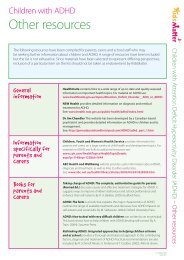
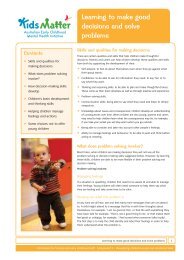
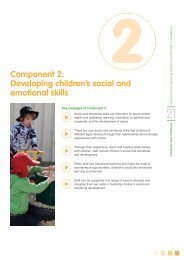
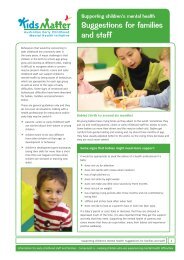
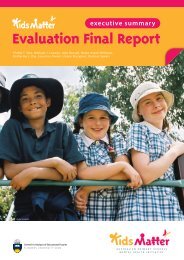

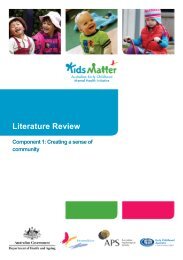
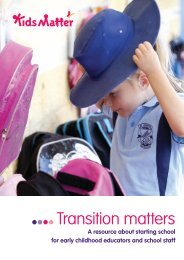
![Trinity Anglican School - Cairns story [378KB]pdf - KidsMatter](https://img.yumpu.com/41716076/1/184x260/trinity-anglican-school-cairns-story-378kbpdf-kidsmatter.jpg?quality=85)
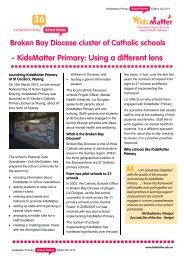
![Happy families work together [327KB] PDF - KidsMatter](https://img.yumpu.com/40767384/1/184x260/happy-families-work-together-327kb-pdf-kidsmatter.jpg?quality=85)
![Action Team Handbook 2012 [1.9M] [PDF] - KidsMatter](https://img.yumpu.com/38050920/1/184x260/action-team-handbook-2012-19m-pdf-kidsmatter.jpg?quality=85)
![[1008KB]pdf - KidsMatter](https://img.yumpu.com/38050895/1/184x260/1008kbpdf-kidsmatter.jpg?quality=85)
